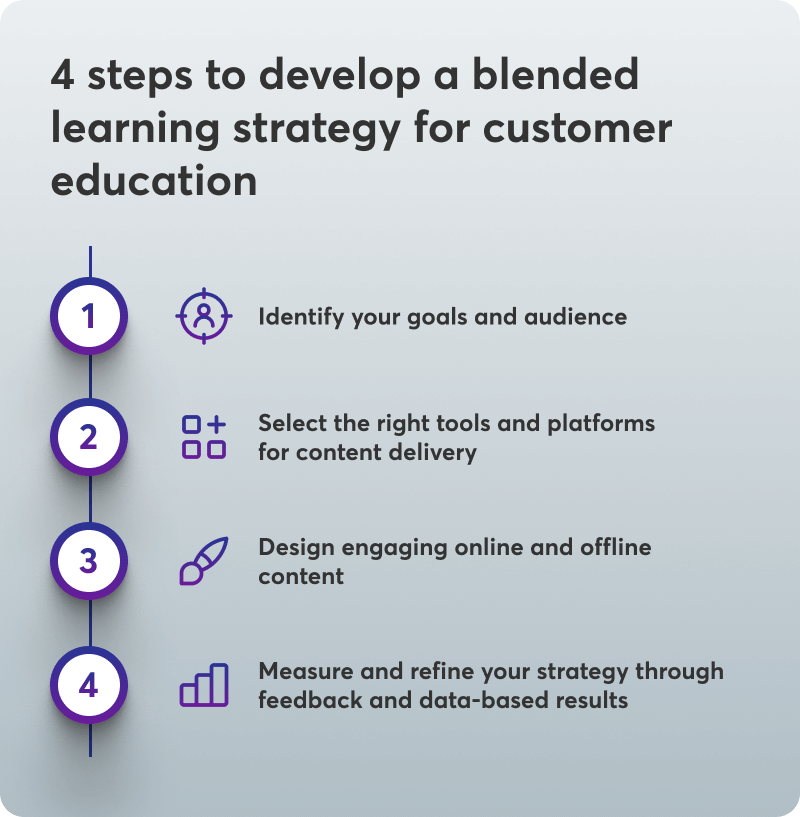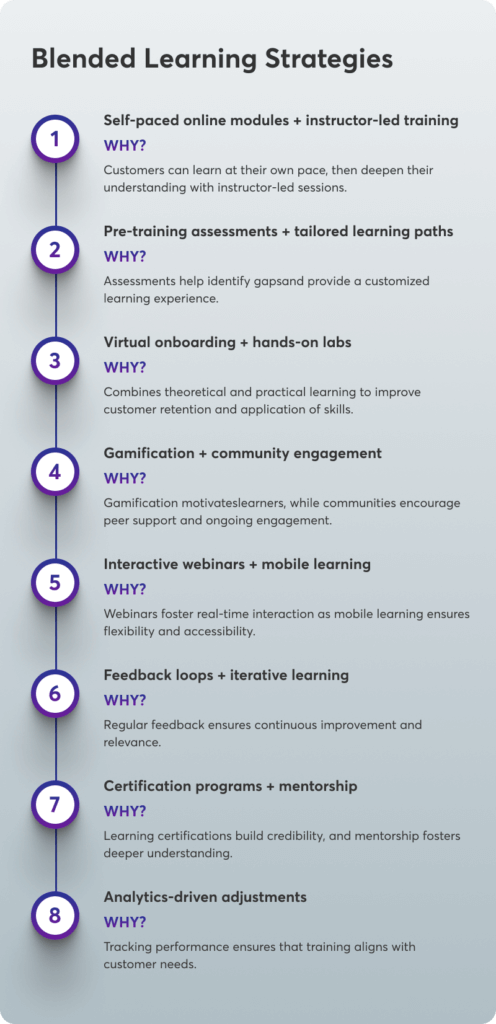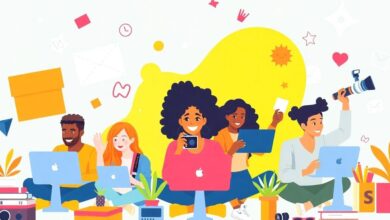How to develop an online blended learning strategy for customer education

Haven’t you always dreamed of offering customers a smooth onboarding, stellar product adoption, and memorable customer satisfaction?
For years I tried to do this the classic way: Taking each of the above, one step at a time. That is until I realized I could use blended learning to achieve everything at once.
In this article, I’m taking you through how you can create your own online blended learning strategy for customer education to build engagement and improve customer success.
15,000+ brands trust LearnWorlds to train their people, partners & customers.
What is blended learning?
Blended learning combines traditional classroom instructions and face-to-face learning with online learning strategies. When used for customer education, blended learning lets businesses create hybrid training experiences that reunite online resources with instructor-led sessions for an advanced, clear, and flexible learning virtual environment.
💁Compare traditional classroom learning vs online learning.
Why use blended learning for customer education?
Some of the core benefits of blended learning and the reasons why I use it whenever I create educational/training content for customers are:
Learners can access online materials at their convenience, eliminating geographical and time constraints, regardless of their different learning styles (like visual learners or fans of face-to-face instruction).
You can easily edit everything for large customer bases across different regions and time zones.
It’s easier to create (and track) interactive and personalized learning paths that are more likely to keep customers engaged.
You have loads of tools for tracking progress and performance so you can tweak the learning experience as you go.
By mixing on-demand and live learning, you’ll find it easier to reinforce key concepts, leading to better customer retention and mastery of product knowledge—without the extra interventions from your team.
The high level of customization options blended learning offers means you can deliver the exact instructional content that customers with different needs want.
You can get the same results by applying some of the following steps.
4 steps to develop a blended learning strategy for customer education
Creating a successful blended learning strategy requires careful planning and execution. I’ve narrowed down the list to four essential steps:
1. Identify your goals and audience
Before you create your course content, get to know your audience, and their pains, needs, and jobs to be done. You’ll use these to set SMART goals and learning objectives for your training materials so they align with what customers want and their desired outcomes.
Start by defining what knowledge and skills you want customers to gain from the training. Are you focusing on product onboarding, troubleshooting, or training for advanced product features?
Narrow it all down to a couple of customer segments so you can start with tailoring learning paths for them first. For example, you’ll most likely always need content for beginners. For them, prepare foundational training but don’t leave aside in-depth product training for advanced users.
2. Select the right tools and platforms for your learning activities
The right tool will make creating a blended learning program a breeze. An LMS (Learning Management System) solution like LearnWorlds, for instance, supports both live and on-demand content delivery.
The platform integrates with popular video conferencing tools like Microsoft Teams, Zoom, and Webex for easier live learning experiences. It also comes with tools for flexible content creation and distribution of multimedia content like interactive videos. Its real-time tracking and analytics capabilities also mean you can monitor customer progress and student engagement to refine the content when needed.
3. Design engaging online and offline content
I’ve noticed that creating a variety of online learning materials has repeatedly been the key to maintaining engagement in any blended learning program.
In a blended classroom, I use self-paced modules that include videos, interactive quizzes, and reading materials for customers who prefer to take their time and get into the more advanced nooks and crannies of a product. For a boost of trust, schedule live webinars, workshops, or Q&A sessions where customers can interact with instructors in real-time.
You can also mix things up by incorporating interactive elements like simulations, case studies, and gamification to keep customers engaged and help them apply their learning.
4. Measure and refine your strategy
After your blended learning program is live… well, you’re not done yet. The most important part (and something you can do before you refine your next customer education strategy) is looking at how they’re performing.
Use analytics tools to monitor completion rates, quiz scores, and time spent on different modules. I’d also stress how important it is to try to collect immediate feedback from participants through surveys and online course evaluations.
Aim for monthly or quarterly feedback-gathering sessions to understand what’s working, what needs improvement, and how potential market trends or customer demands change their behavior.
Key challenges and how to overcome them
While blended learning offers many benefits, there are a few challenges you may encounter when you want to incorporate blended learning into your teaching strategies to engage students.
One key aspect is fostering a deeper understanding, which plays a crucial role in enhancing critical thinking and problem-solving skills.
1. Low engagement rates
Customers may not engage fully with online content if it’s not interactive or relevant. To overcome this, I try to make sure my content is engaging. That means no more boring videos and black-and-white downloadable resources. Use gamification and offer regular live touchpoints such as webinars or Q&A sessions for a personal interaction touch.
2. Technical issues
Technical problems shouldn’t happen in today’s age. As you get started with a blended learning model, invest in reliable platforms that integrate smoothly with other tools (such as video conferencing software) and provide customer support in case of issues.
3. Balancing self-paced and live learning
Striking the right balance between self-paced learning (learning at your own pace) and live learning has always been something I struggled with.
I found the best method to nail this in a blended approach is to structure your on-demand training materials well and make sure customers find these valuable before you even transition to live, instructor-led sessions and jump into deeper insights.
Successful blended learning strategies
Here are some real-world examples of blended learning strategies that work for customer education:
Self-paced online modules + instructor-led training
Combining self-paced modules with instructor-led training offers flexibility and personalized guidance. Learners can study foundational content independently, reserving live sessions for deeper discussions and hands-on practice. This approach ensures a comprehensive learning experience.
Example: Create self-paced e-learning modules with videos, infographics, and quizzes to introduce any new concept. Follow up with live webinars or workshops for Q&A and advanced topics.
💡Connect LearnWorlds to your favorite conferencing tool—Zoom, Webex, or Microsoft Teams—to record live webinars and product demonstrations and turn them into on-demand training resources. Maximize the potential of your live events and create invaluable resources for your customers, quick and easy.
See how to connect LearnWorlds with video conferencing tools in our support article.
Pre-training assessments + tailored learning paths
This combination ensures learners start at the right level and receive content that matches their individual needs. Assessments identify gaps, while tailored paths prevent overwhelm by focusing only on relevant material. Use interactive diagnostics like simulations or scenario-based quizzes to assess practical skills, not just theoretical knowledge.
Example: Use pre-course surveys or quizzes to assess customers’ knowledge. Based on their scores, assign them to beginner, intermediate, or advanced learning tracks.
Virtual onboarding + hands-on labs
Theoretical knowledge alone isn’t enough—combining onboarding with hands-on labs reinforces learning through real-world practice. This lets you improve customer retention and the application of skills. Offer guided product tours within the platform and interactive tutorials that adapt based on user actions.
Example: Deliver onboarding sessions via live webinars to introduce customers to your product. Pair this with sandbox environments or interactive labs where they can practice without risk.
Gamification + community engagement
Motivation and support go hand in hand. Gamification motivates learners, while communities encourage peer support and create a sense of belonging. Group projects also play a crucial role in facilitating peer interaction and active engagement. Introduce leaderboards or monthly challenges where top learners get featured in newsletters or product updates.
Example: Use gamification elements like badges and gamify your courses by setting prerequisites (e.g., passing a quiz) before a learner can unlock the next level/lesson. Create forums or social groups where customers can share insights and successes.
Interactive webinars + mobile learning
Webinars foster real-time interaction, while mobile learning ensures flexibility and accessibility. Together, they make for flexible, interactive learning. Create short, mobile-friendly micro-lessons learners can watch between webinars to reinforce learning.
Example: Conduct live sessions where participants can ask questions or engage in polls. Blend live and on-demand webinars to educate customers on LearnWorlds’ integrations with MS Teams, Zoom, and Webex. Complement this with a mobile app that provides access to resources anytime.
Feedback loops + iterative learning
Learning needs to evolve, so continuous feedback ensures content stays relevant and effective. This approach helps refine materials and enhance future learning experiences. Implement automated in-course feedback pop-ups asking learners about their current understanding, allowing real-time content adjustments.
Example: Gather customer feedback through surveys or post-training discussions. Update course materials and deliver follow-up sessions based on their suggestions.
Analytics-driven adjustments
Data-driven decisions ensure learning programs remain effective. Analytics help track progress so you can ensure training aligns with customer needs. Set up automatic alerts when learners struggle with specific modules, prompting personalized coaching sessions or targeted content updates.
Example: Use LMS analytics to monitor progress and engagement. Identify bottlenecks and adapt your blended strategy accordingly.
Ready to start offering blended learning programs?
Blended learning gives you a flexible, scalable, and engaging solution for customer education. By bringing together self-paced online learning with instructor-led sessions, businesses can create a dynamic and personalized blended learning experience that drives customer success.
Adopting an online blended learning strategy enhances the customer onboarding process and empowers customers to become more proficient with your product, ultimately reducing churn and boosting long-term loyalty.
Ready to get started with blended learning? Explore how LearnWorlds and its live integrations, customizable learning paths, detailed analytics, and more can make developing a successful blended learning strategy seamless—or free.
15,000+ brands trust LearnWorlds to train their people, partners & customers.
FAQs
What tools are needed for blended learning?
Blended learning requires an LMS for content management and tracking, video conferencing tools (such as Zoom or MS Teams) for live sessions, content creation software for multimedia materials, and analytics tools to monitor learner progress and engagement.
Can blended learning work for all industries?
Yes, blended learning is versatile and can be adapted across industries like SaaS, healthcare, retail, and finance. The key is tailoring the content and delivery methods to the specific needs of the industry and audience.
How do you measure the success of a blended learning program?
Success can be measured by tracking completion rates, learner satisfaction through surveys, performance improvements via assessments, and long-term customer retention or product adoption metrics.
(Visited 6 times, 6 visits today)

Alexandra Cote
Alexandra Cote is a SaaS growth marketer and online instructor who’s worked with dozens of brands in the MarTech, HR tech, and productivity space. She’s also a strong supporter of staying happy at work and choosing a healthy career path.





